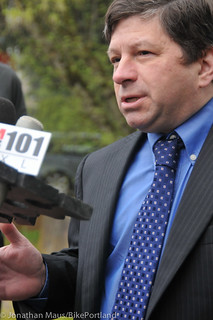
for the upcoming debate about
transportation spending.
(Photo by J. Maus/BikePortland)
If The Oregonian’s opinion pages are any indication, the City’s campaign to persuade Portlanders to help fund transportation investments is heating up.
On New Year’s Day, the leader of a local walking advocacy group called on Transportation Commissioner Steve Novick and Mayor Charlie Hales to step up for street safety. Then on Saturday (1/11), Novick used The Oregonian’s opinion section to publish his plea for more money to spend on “investments in sidewalks, flashing beacons and other pedestrian amenities.” One day prior to Novick’s article, the Oregonian Editorial Board shared their perspective on what our transportation spending priorities should be
Novick’s article comes as walking advocates pressure the city to step up in light of the 10 people who died while walking in 2013 and while the Portland Bureau of Transportation assembles the pieces of a major campaign to raise new revenue.
Oregon Walks president Aaron Brown also published a guest article in The Oregonian that referred to the deaths as a “public health epidemic.” Brown’s piece opened with, “In Portland, you should be able to walk your dog across the street without fear that you won’t make it to the other side.”
In his piece on Saturday, Novick said he agrees with Brown.
Here’s an excerpt from Novick’s article:
“Aaron Brown is right: Pedestrian fatalities are terrible tragedies, some of which could be avoided by making investments in sidewalks, flashing beacons and other pedestrian amenities. Brown is also right that East Portland has a disproportionate share of pedestrian collisions, in part because it has a disproportionate share of dangerous intersections and streets without sidewalks… The need for additional investments in safety improvements is one of the reasons Mayor Charlie Hales and I have made it clear that we think it will be necessary to raise additional revenue for transportation in Portland.The need for additional investments in safety improvements is one of the reasons Mayor Charlie Hales and I have made it clear that we think it will be necessary to raise additional revenue for transportation in Portland.”
As we reported last month, Novick plans to use every possible opportunity that arises to promote what many people believe will be a new “street fee” to fund transportation infrastructure.
While Novick and Brown are putting sidewalks and safer crossings front and center in the discussion about transportation spending, The Oregonian Editorial Board’s recent foray into the same topic made no mention of them. In their article published on Friday (January 10th), The Oregonian Editorial Board stumped for “unimpeded” auto traffic flow and more, wider roads. Their article painted a picture of frustration for people who drive and deal with congestion on Portland area highways while it dismissed the role of bicycles and mass transit.
The Oregonian editors blamed “a profusion of bicyclists competing for limited space on roadsides” as just one reason why, “People often struggle to get to their destinations on time.” While they gave a nod to bicycles as, “an efficient, healthful mode of transit that needs to find expansion through a deeper integration into greater Portland’s transportation infrastructure,” they said instead of aspiring to be the “next Amsterdam” the “more realistic and productive conversation turns on how to make things better for both cars and bikes…”
The Oregonian’s top thinkers aspire to a future that looks like the fantasy landscape we often see in car commercials. “Unimpeded circulation within the city,” they write in the final line, “and throughout its suburbs, is the region’s lifeblood.”
With a citywide transportation funding package imminent, we expect a lot more opinions to be shared in the coming months. In that time, Portland will have to decide the balance of our priorities. Will it be possible to create (and fund) conditions for “unimpeded circulation with the city” while still making our streets safe to walk and bike on?

